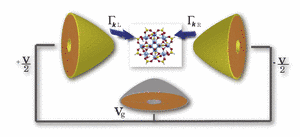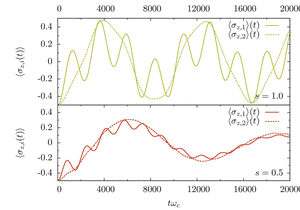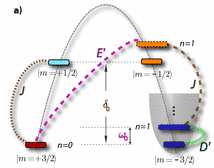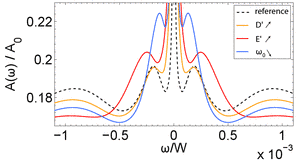Transport and dynamics in nanostructures
 We are interested in transport in nanostructures. The effects of the surrounding (conduction band) electrons or the (bosonic) excitations of the very small structures in these systems are usually described by quantum impurity models. Here the small structure is represented by semi-empirical effective models with only a few degrees of freedom, which couple to a large number of "bath" eigenstates accounting for the surrounding of the nanometer sized structure. At very low temperatures electronic transport through these small structures is affected by the Kondo effect [1]. The interplay of the long-range correlations in the "bath" with the different degrees of freedom on the impurity opens up a variety of interesting physics. In the following we will present two different topics of this field which members of our group are involved in.
We are interested in transport in nanostructures. The effects of the surrounding (conduction band) electrons or the (bosonic) excitations of the very small structures in these systems are usually described by quantum impurity models. Here the small structure is represented by semi-empirical effective models with only a few degrees of freedom, which couple to a large number of "bath" eigenstates accounting for the surrounding of the nanometer sized structure. At very low temperatures electronic transport through these small structures is affected by the Kondo effect [1]. The interplay of the long-range correlations in the "bath" with the different degrees of freedom on the impurity opens up a variety of interesting physics. In the following we will present two different topics of this field which members of our group are involved in.
Spin synchronization via a bosonic bath after a quantum quench
We study a model for two single spins, which are coupled to the same bath of bosonic particles. Such a system can, for example, describe a the effect of a bath of phonons in a semiconductor coupling to two quantum dots. This system can be modeled by a generalization of the well-known spin-boson model [2]:
 |
where the bath of bosons is characterized by its spectral density
Depending on the strength of the coupling between the bath and the two spins α1=α2 and the value of the the "bare" Ising interaction between the two spins K, the system can be in one of the two different phases: the localized phase, where a small perturbation suffices to polarize the system in one of the two degenerate groundstates with finite magnetic moment ( |↑↑⟩ or |↓↓⟩) or the delocalized phase, where entanglement of the spins with the bosonic bath is not strong enough to polarize the impurity spins. The system cannot localize in a state where the two spins are aligned antiferromagnetically (|↑↓⟩ or |↓↑⟩), since the common bosonic bath for both of these states is identical and a tunneling between the two states is thus always allowed, which is equivalent to saying that the spins are delocalized.
The common bosonic bath correlates the two spins, such that the effective Ising interaction reads Kr = K - 4 α/(ωc s)
We found that for both ohmic (s=1) and sub-ohmic (s=0.5) bath dispersion the spins are always delocalized for effective antiferromagnetic Ising interaction Kr > 0.
 |
Additionally the renormalized Ising interaction Kr manifests itself in the time-evolution of the two spins. Preparing them in a ferromagnetic state for times t<0 by applying a large initial level asymmetry ε1=ε2>>ω_c we switch off the level asymmetry for times t>0 and study the oscillations caused by the spin flip tunnelings Δ1 and Δ2. If we choose different strengths Δ1 ≠ Δ2 we observe oscillations with different frequencies for the two spins, if they are not coupled to the common bosonic bath.
Coupling them to the bosonic bath we can study the effect of the bath correlations on the time evolution of the two spins: for relatively small coupling strengths: the two spins synchronize. It turns out that the bath dispersion relation plays a crucial role in the synchronization of the two spins: for a sub-ohmic dispersion (s=0.5) the coupling to the bath sufficient to synchronize the spins is weaker than in the ohmic case (s=1).
To study the nonequilibrium time evolution of the two spins, we applied an extension of the numerical renormalization group method (NRG), which allows us to calculate the real-time evolution of an impurity observable as a reaction to a sudden change in the Hamiltonian [3]
Kondo effect and spin-vibration coupling in single molecule magnets.
 |
Another interesting topic in this field our group is actively involved in, is the investigation of transport through single molecule magnets, which are a class of complicated molecules (for example Mn12-acetates or Fe8 compounds) with an intrinsic magnetic moment formed by their ion centers. Their large effective spin S prefers to align along a certain axis due to the symmetry of the molecule and the interaction of the ion centers with the other constituents. At very low energies this energy barrier ~DSz2 can be overcome and the molecule can show so called "quantum tunneling of magnetization" if the transverse anisotropy E of the molecule (which is connected to the rotational symmetry of the molecule) is large enough. Due to recent advances in experimental techniques, it is nowadays possible to isolate and attach these molecules to metallic leads [4] and study the physics caused by the interaction of correlations in the bath and anisotropies of the molecule.
In a recent work we asked how the coupling of the spin to vibrations of the molecule could alter the electronic transport through the molecule at very low temperatures. In this case the Hamiltonian has three different contributions
first coming from the isolated molecule, second describing the metallic leads, and third for the interaction of the molecule with the fermionic bath. Accounting for the spin-vibration coupling the molecule part of the Hamiltonian studied reads
 |
 |
One of the results of our study was that, under certain circumstances, the molecule vibrations induce a Kondo effect [1]. The additional anisotropy parameters D' and E', which are absent if the molecule remains in its vibrational ground state, do have a different effect on the Kondo temperature TK than the "original" parameters D and E: TK increases with both E' and D' as they cooperate to couple the groundstates of the single molecule magnet. In the "usual" Kondo effect in these molecules TK grows with the ratio E/D,
The fact that the Kondo temperature increases with both vibrational anisotropies might be of great interest for experimentalists working on transport through SMM. The positive aspect of this is that dynamical distortions which lower the symmetry of the SMM tend to enhance the Kondo temperature, improving the possibility for experimental observation.
References
[1] Kondo effect on scholarpedia.org http://www.scholarpedia.org/article/Kondo_effect
[2] Ulrich Weiss, "Quantum Dissipative Systems"; 3rd ed. World Scientific (2008)
[3] Frithjof Anders and Avraham Schiller, "Spin Precession and Real Time Dynamics in the Kondo Model: A Time-Dependent Numerical Renormalization-Group Study", Phys. Rev. B 74, 245113 (2006)
[4] H.B. Heersche et al., "Electron Transport through Single Mn12 Molecular Magnets", Phys. Rev. Lett. 96, 206801 (2006)





